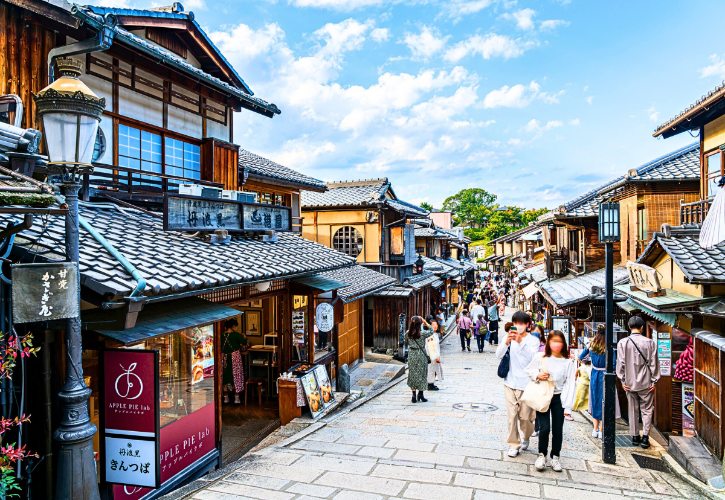
Planning a trip to Kyoto can feel overwhelming. This 3-day guide makes it simple by showing you exactly what to do, where to eat, and how to get around.
I’ll share the city’s must-see temples and shrines, traditional local cuisine, and historic districts like Gion.
With detailed bus and train directions, you can explore Kyoto like a pro.
Skip the endless research – just follow this super detailed itinerary to make the most of your time in Japan’s cultural heart. 😊
Day 1: Kiyomizudera Temple, Kyoto Gion, Yasaka Shrine and Pontocho Alley
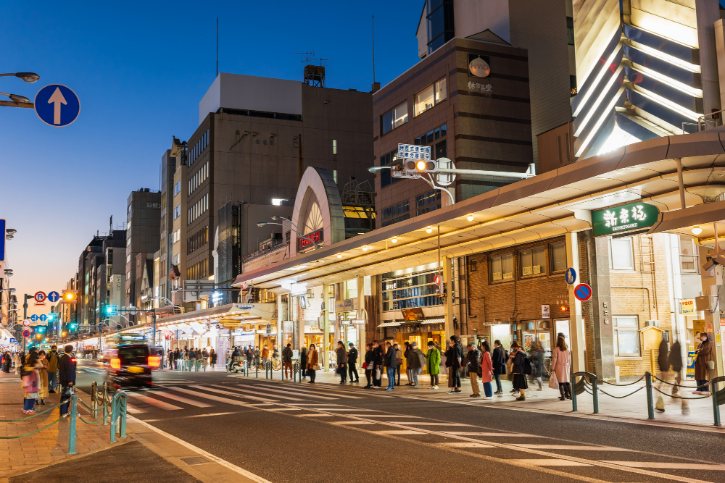
9:00 AM: Hotel Check-In
One of the best areas to stay in Kyoto is near Shijo Station and Karasuma Station.
Why Stay Near Shijo-Karasuma: The Heart of Kyoto
- Direct connection to Kyoto’s extensive subway and bus networks
- Seamless 50-minute journey from Osaka-Umeda Station to Karasuma Station via Hankyu-Kyoto Line
- Easy access to major attractions like Kiyomizu-dera, Nijo Castle, Hanamikoji Street and Nishiki Market
- Diverse dining options from casual izakayas to refined Kyoto cuisine
- Cozy bars and lounges in atmospheric Pontocho district
- Vibrant Shinkyogoku Shopping Street with fashion, souvenirs, and local delicacies
- Premium department stores including Daimaru and Takashimaya
Recommended Hotels

- Hotel Forza Kyoto Shijo Kawaramachi (Agoda | Booking.com)
- Location & Transport:
- Located in Kyoto’s lively shopping and dining district, close to Nishiki Market and Teramachi shopping arcade. Ideal for exploring the city.
- 7-minute walk from Shijo Subway Station (Karasuma Line) and Kyoto-Kawaramachi Station (Hankyu Line).
- 5-minute walk from Karasuma Station, offering direct trains to Osaka-Umeda Station without any transfers, perfect for traveling between Kyoto and Osaka.
- Nearby bus stops provide easy access to popular attractions like Kiyomizu-dera and Kinkaku-ji.
- Taxis are easy to catch along nearby Shijo Street, convenient for short trips around town.
- Convenience:
- FamilyMart is located right next to the hotel, and a 7-Eleven is just across the street. Both are open 24 hours for snacks, drinks, and quick meals.
- Coin laundry machines are available in the hotel with detergent provided. You can easily check the laundry status from your phone using a QR code.
- Personal Experience:
- I stayed here myself and found the area vibrant and lively, with plenty of shops, restaurants, and convenience stores just steps away.
- Location & Transport:
- Sotetsu Fresa Inn Kyoto Shijo Karasuma (Agoda | Booking.com): 2 minutes’ walk from Karasuma Subway Line (Shijo Station Exit 4) and Hankyu Kyoto Line (Karasuma Station Exit 23). Simple and stylish room design.
- Hotel M’s Est Shijo Karasuma (Agoda | Booking.com): 1 minute’s walk from Karasuma Subway Line (Karasuma Station Exit 19) and 3 minutes’ walk from Hankyu Kyoto Line (Shijo Station Exit 1). Close to Shijo Kawaramachi’s department stores and restaurants.
- Mitsui Garden Hotel Kyoto Shijo (Agoda | Booking.com): 7 minutes’ walk from Karasuma Subway Line (Shijo Station Exit 2) and 6 minutes’ walk from Hankyu Kyoto Line (Karasuma Station Exit 26). Various room types available from Single to Quad, perfect for different group sizes.
Read More: Only 2 Best Places to Stay in Kyoto
10:00 AM: Kiyomizudera Temple
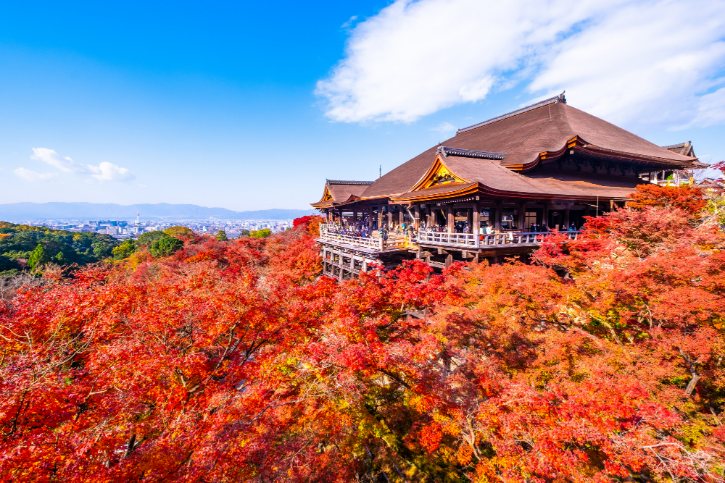
a. Key Highlights
- Founded in 780 AD, Kiyomizudera stands as one of Kyoto’s most beloved temples
- Its cultural significance earned it a spot on UNESCO’s World Heritage list
- The name means “Pure Water Temple,” thanks to the beautiful natural spring that flows here
- The temple sits high up, giving you stunning views over all of Kyoto
b. Main Attractions
- Plan your visit during spring to see cherry blossoms or autumn for red maple leaves
- Don’t miss the Main Hall’s wooden stage – it stands 13 meters high and offers breathtaking city views
- Stop by Jishu Shrine, a special place where people pray for good luck in love
- At the entrance, you’ll spot an impressive 31-meter pagoda reaching toward the sky
c. Cultural Experiences
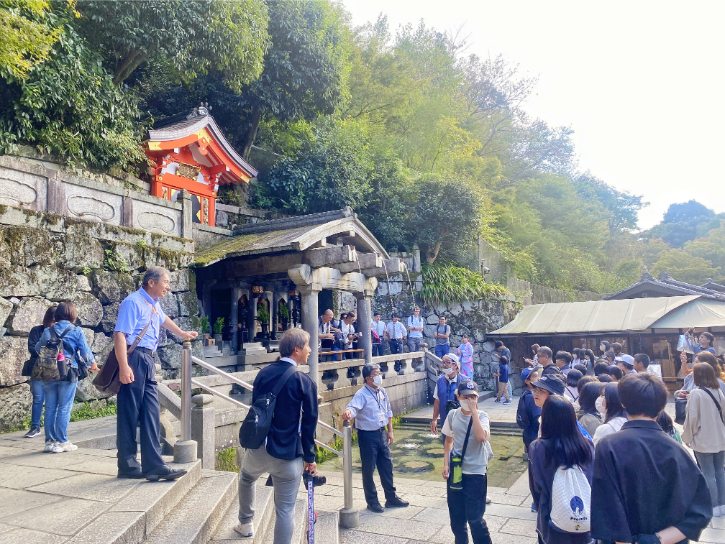
- Visit the famous Otowa Waterfall with its three streams of pure water:
- Drink from the first stream for good health
- Choose the second for success in life
- Pick the third for luck in love
- (Remember: pick just one stream – drinking from all three is considered unlucky!)
- Join local tradition by ringing the temple bells and leaving a small offering in the Main Hall
- Test your luck in love at Jishu Shrine by trying to walk between two special stones with closed eyes – success means good fortune in romance
d. How to Get There
From Hotel Forza Kyoto Shijo Kawaramachi: Walk to the bus stop at Shijo Kawaramachi, then take bus #207 to Kiyomizu-michi bus stop. The entire trip takes about 18 minutes and costs 230 yen. From the bus stop, it’s a 10-minute uphill walk to the temple entrance.
11:30 AM: Sannenzaka
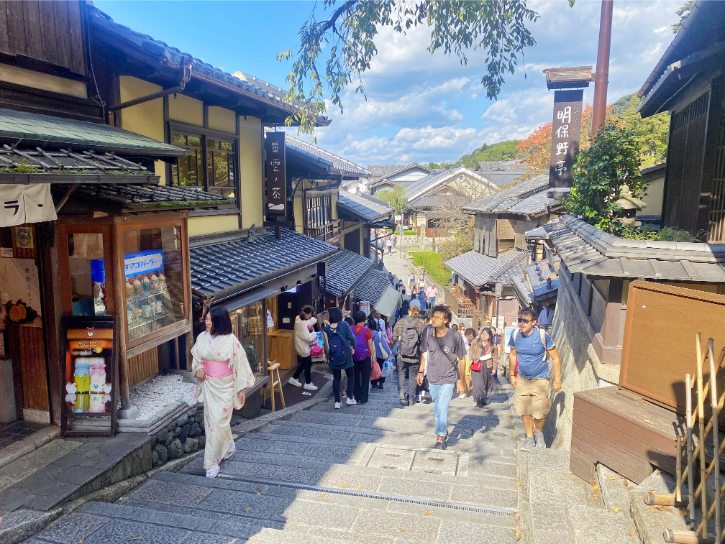
a. Key Highlights
- Step into a beautiful old street where traditional wooden buildings line both sides
- Experience Kyoto as it was in ancient times
- Called “three-year slope” in Japanese
- Browse through shops filled with local crafts, perfect souvenirs, and tasty treats
b. Exploring the Historic Street
- Stroll down a charming 150-meter path that curves and climbs gently
- See beautiful townhouses (machiya) that have stood since the old days of Japan
- Watch as gas lamps light up the street at sunset, creating a magical atmosphere
- Bring your camera – this picturesque street is so beautiful it appears in many TV shows
- Make it a perfect walk by visiting nearby Ninenzaka street and Kiyomizudera Temple
c. Must-Try Local Food Spots
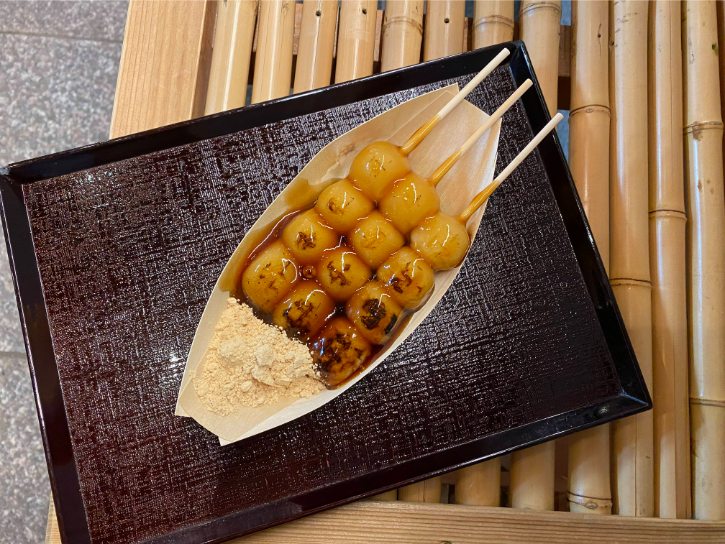
- Fujinami: Get a taste of old Kyoto with their refreshing iced matcha and dango (rice dumplings) – try their special soy sauce dango!
- Kirakuan Okamoto Sanneizaka: Don’t miss their cute “Maiko-yaki” snacks shaped like apprentice geisha. Choose from red bean, cream, matcha, or ham & cheese fillings. Their croquettes are also delicious.
- Okutan Kiyomizu: Famous for fresh, handmade tofu. Their soy milk and black honey shaved ice are local favorites.
- Ukiya Kiyomizu Kiseian: Known for handmade soba noodles, but their oyakodon (rice bowls) with crispy fried shrimp is a must-try.
- Umezono Kiyomizu: A sweet shop since 1927, serving traditional Japanese treats like matcha, shiratama zenzai (sweet red bean soup with rice balls), warabi mochi, and seasonal desserts.
d. How to Get There
From Kiyomizudera Temple: It’s a 3-minute walk to Sannenzaka.
12:20 PM: Yasaka Pagoda
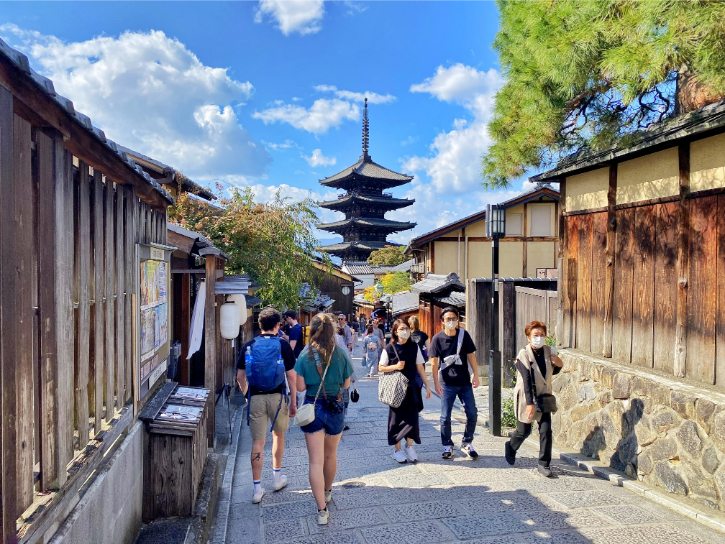
- Striking five-story pagoda in Higashiyama District
- One of Kyoto’s most photographed landmarks
- 46 meters tall – third highest wooden building in Kyoto
- Perfect photo spot among traditional streets
How to Get There
From Sannenzaka: It’s a 3-minute walk to Yasaka Pagoda.
12:30 PM: Ninenzaka
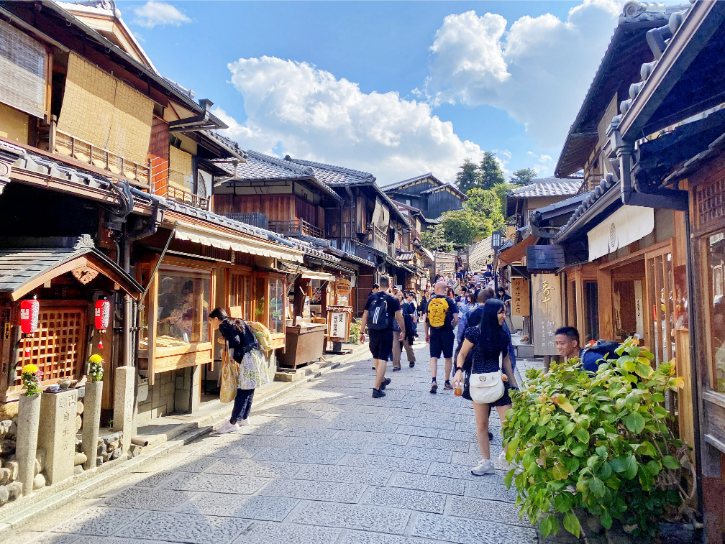
a. Key Highlights
- Located right next to Sannenzaka in Kyoto’s Higashiyama area
- Called “two-year slope”
- Features beautifully preserved old Kyoto buildings
- Perfect spot for capturing traditional Japanese street scenes
b. What You’ll Find
- Beautiful old tea houses and traditional restaurants
- Shops selling authentic Japanese crafts and treats
- Lucky visitors might spot real geishas and apprentice geishas (maikos), especially in evening hours
- Charming mix of modern shops in historic buildings
c. Must-Try Food Spots
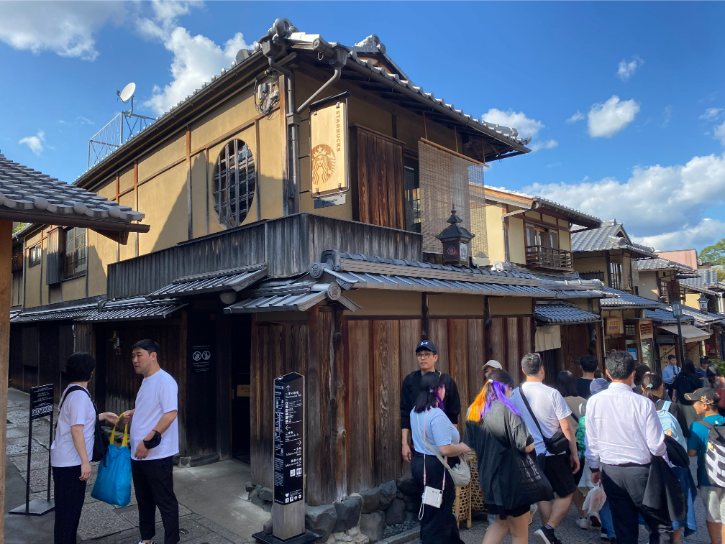
- Starbucks Kyoto Nineizaka: Not your usual coffee shop – enjoy drinks while sitting on traditional tatami mats.
- Ishidatami: Famous for their matcha soft-serve ice cream with special homemade sauce.
- Fujinami Kodai-ji: Try their handmade Kyoto-style dango (rice dumplings) and mochi.
- Kasagiya: Step back in time at this old-style sweet shop – don’t miss their o-hagi (sweet rice cakes) and zenzai (warm sweet red bean soup).
d. How to Get There
From Yasaka Pagoda: It’s a 2-minute walk to Ninenzaka.
1:30 PM: The Sodoh Higashiyama Kyoto/ Hisago/ Gyukatsu Kyoto Katsugyu – Gion Yasaka (Lunch)
a. The Sodoh Higashiyama Kyoto
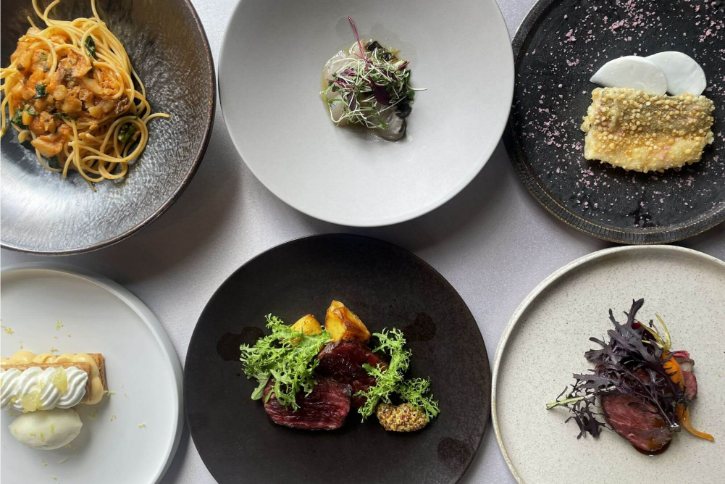
- Italian-Japanese fusion in a historic building
- Popular Dishes: Tagliatelle with Omi beef, sea bream with tangerine peel
- Must-Try Dessert: Basque cheesecake with coffee
- Budget: 11,000-15,000 yen per person
How to Get There
From Ninenzaka: It’s a 2-minute walk to The Sodoh Higashiyama Kyoto.
b. Hisago
- Famous for oyakodon (chicken and egg rice bowl)
- Best Dish: Oyakodon with Tanba chicken and Kujonegi leeks
- Try Also: Matcha soba made with Uji green tea
- Local Favorite: Kinugasadon with fried tofu and egg
- Budget: 800-1,500 yen per person
How to Get There
From Ninenzaka: It’s a 6-minute walk to Hisago.
c. Gyukatsu Kyoto Katsugyu – Gion Yasaka
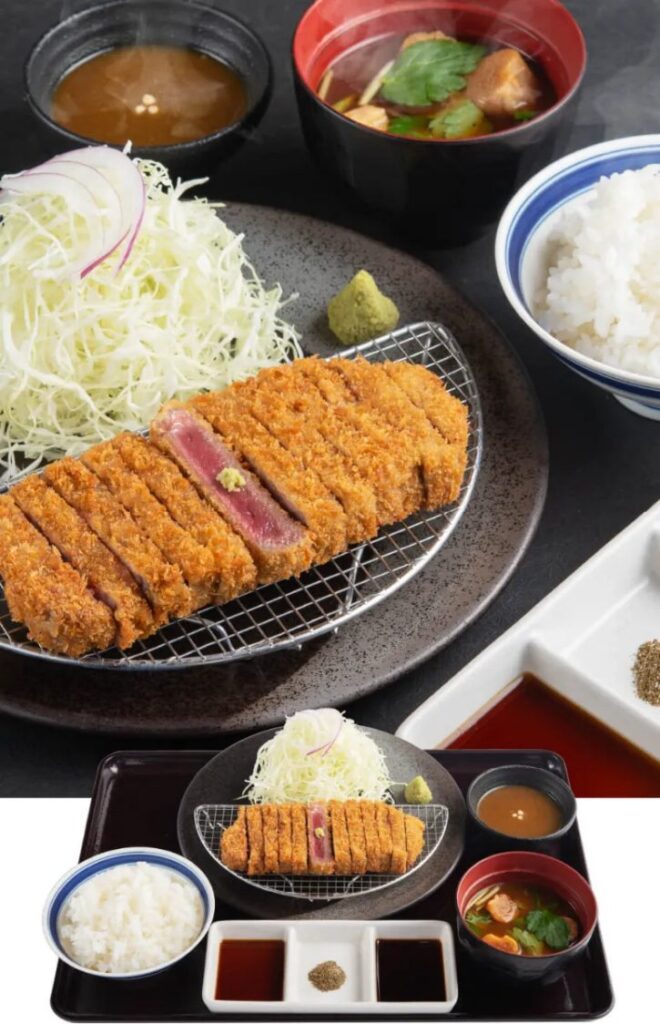
- Best known for beef cutlets (gyukatsu)
- Star Dish: Sirloin Gyukatsu Zen set with premium beef
- Special Feature: Hot stone for cooking meat to your taste
- Perfect With: Wasabi soy sauce, sansho pepper salt
- Budget: 2,000-3,000 yen per person
How to Get There
From Ninenzaka: It’s a 10-minute walk to Gyukatsu Kyoto Katsugyu – Gion Yasaka.
2:30 PM: Yasaka Shrine

a. Key Highlights
- One of Kyoto’s oldest shrines – it’s been here for over 1,350 years!
- Home to the Gion Matsuri, one of Japan’s biggest and most beloved festivals
b. Main Attractions
- Begin at the bright red West Gate – it’s a great photo spot!
- Look for the two Zuishin warriors standing guard at the gate
- Admire the special stage for dance performances near the main hall, with beautiful lanterns all around
- Visit the main building where people pray and make offerings
- Come at night when hundreds of lanterns light up – it’s magical!
c. Cultural Experiences
- Join local tradition: ring the bells and leave a small offering at the main hall
- Stop by Utsukushii Gozen-sha shrine to pray for beauty – it’s a favorite spot for Kyoto’s geiko and maiko (traditional entertainers)
- Look for the many lanterns around the shrine – each displays the name of a local business
- Join the big Gion Festival if you’re here in July
- In spring, enjoy the beautiful cherry blossoms in the connected Maruyama Park
d. How to Get There
From the Restaurants Mentioned Above: It’s about a 5-minute walk to Yasaka Shrine.
4:00 PM: Hanamikoji Street

a. Welcome to Hanamikoji Street
- Located in the heart of historic Gion, Kyoto’s most famous geisha district
- Famous for its preserved row of traditional wooden machiya buildings
- Best known spot in Kyoto for seeing authentic geiko (geisha) and maiko (apprentices)
- Perfect blend of old Kyoto with traditional teahouses alongside modern restaurants and shops
b. What You’ll See Here
- Look for the beautiful red lattice windows and wooden walls of the old houses
- Discover fancy traditional restaurants (ryotei) and teahouses that have been here since the old days
- Watch for elegant maiko (apprentice geisha) or geiko (Kyoto’s geisha) walking to their appointments
- Wander down the quiet side streets to see even more of historic Gion
c. Cultural Etiquette
- If you see a maiko or geiko, admire from a distance without obstructing their path or requesting photos
- Keep your voice down, especially in the evening when the teahouses are busy
- Follow any “no photography” signs you see – they’re there to protect privacy
d. How to Get There
From Yasaka Shrine: It’s about a 5-minute walk to Hanamikoji Street.
5:00 PM: Saryo Tsujiri Tea House (Gion Main Store)

- Enjoy authentic Japanese treats made with premium matcha from Uji
- Try their most popular dessert – the Tokusen Tsujiri Parfait: layers of matcha ice cream, sweet red beans, chewy mochi, crunchy cornflakes, and cream with matcha sauce on top
- Grab a refreshing matcha ice cream to go – it’s a perfect walking treat
- Try the dorayaki, a pancake-like treat filled with sweet red bean paste
- Discover their matcha mochi – soft, chewy rice cakes with delicious fillings inside
c. How to Get There
From Hanamikoji Street: It’s about a 2-minute walk to Saryo Tsujiri Tea House (Gion Main Store).
5:30 PM: Kamo River
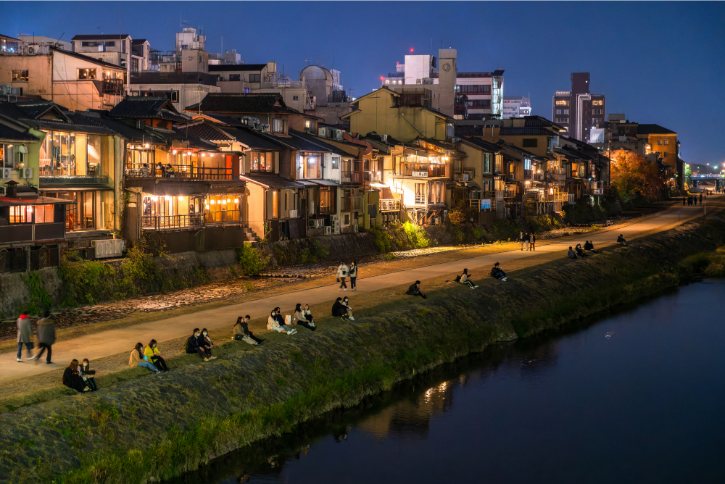
a. Take a Pleasant Walk
- Walk by the river and watch how it changes with the seasons
- Find a peaceful spot between Misono and Kitayama bridges at the river delta
- On hot days, cool your feet in the refreshing water
- Watch locals enjoy their day while you relax by the water
- See beautiful cherry blossoms in spring and colorful leaves in fall
- The river looks especially beautiful during sunrise and sunset – perfect for photos!
b. Dine Along the River
- Many restaurants near Pontocho have outdoor seats where you can see the river
- The area becomes magical at night with glowing lanterns
- Choose from Japanese food or dishes from around the world
c. How to Get There
From Saryo Tsujiri Tea House (Gion Main Store): It’s about a 5-minute walk to Kamo River.
6:00 PM: Pontocho Alley (Dinner)
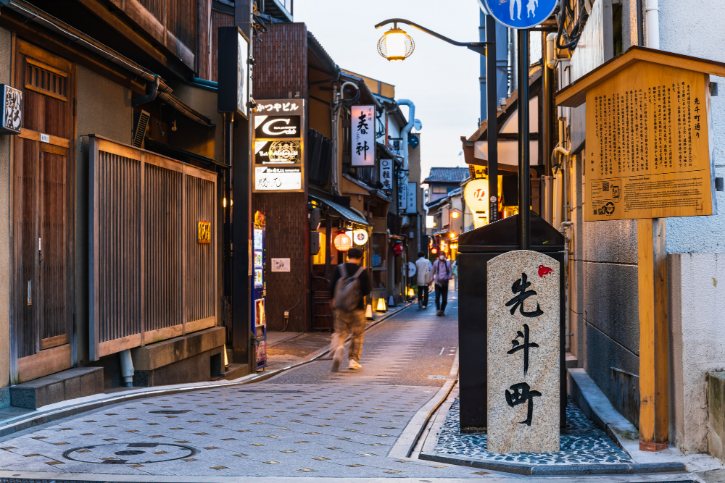
a. Key Highlights
- One of Kyoto’s oldest and best-preserved entertainment streets, established in 1670
- A beautiful narrow street that runs alongside the Kamo River
- Lined with many traditional Japanese restaurants and tea houses
- Home to one of Kyoto’s famous geisha communities
- Beautiful scenery with glowing lanterns and stone-paved streets
b. What to See and Do
- Take a walk down the charming street and see the beautiful old wooden buildings
- Watch traditional dance performances at Pontocho Kaburenjo Theater, especially the special May shows
- Discover the hidden small streets that branch off the main path
- Take pictures of the beautiful scenery, particularly in the evening when lanterns light up
- You might see geishas or apprentice geishas (maikos) – please be polite and give them space
c. Where to Eat (Dinner)
i. Kappa Sushi
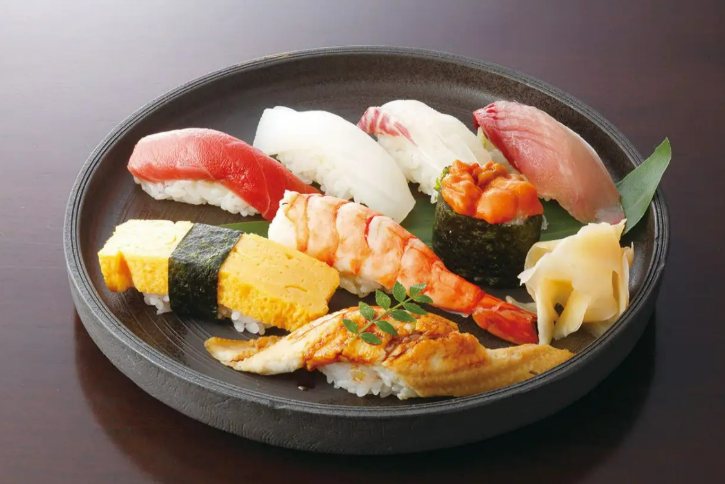
- An affordable sushi restaurant with conveyor belt service
- Watch your sushi being made right at the counter
- Best Dishes: Rich Southern Bluefin Tuna, Red Sea Bream with citrus, Fresh Yellowtail, Big Shrimp, and Hokkaido Abalone
- People Also Love: Fried Pacific Saury with mayo sauce, Special 5-Piece Sushi Set
- Budget: About 1,500-2,500 yen per person
ii. Kichi Kichi Omurice
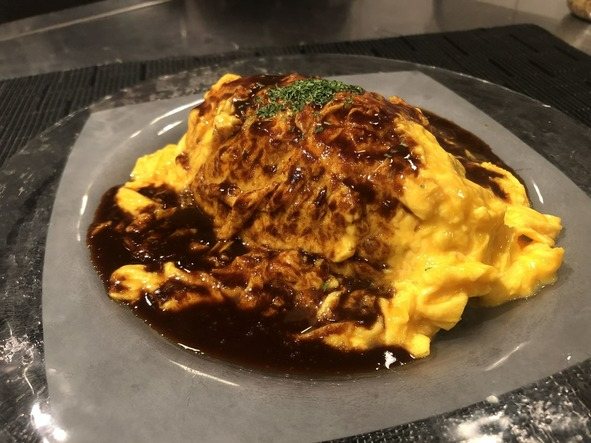
- Famous for their fluffy egg omelette over rice with a fun cooking show
- Must-Try: Their special omurice with smooth egg and rich brown sauce
- Choose From: Cut with knife or “flying” style preparation
- Other Good Picks: Small omurice portion, Hearty Beef Stew, Crispy Chicken Cheese Cutlet
- Budget: 1,450 yen for small size, 2,700-3,250 yen for full meals
iii. Kyoto Yakiniku Hiro Pontocho
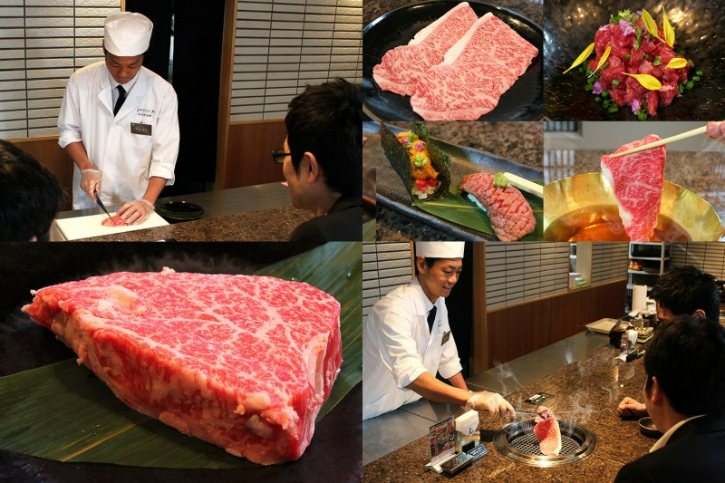
- Cook premium Japanese beef right at your table in a traditional setting
- Best Choice: Mixed platter of different Wagyu beef cuts
- Fan Favorites: Tender beef tongue, flavored short ribs, fresh seasonal vegetables
- Budget: 5,000-8,000 yen per person
iv. Monsen – Kiyamachi
- Perfect for late-night ramen cravings, known for their chicken soup base
- Must-Try: Their signature chicken ramen
- Also Delicious: Roasted pork ramen and vegetable ramen
- Budget: 850-1,200 yen per person
d. How to Get There
From Kamo River: It’s about a 1-minute walk to Pontocho Alley.
7:00 PM: Teramachi Kyogoku Shopping Street

a. Shopping Highlights
- Find beautiful Japanese crafts – from handmade pottery to colorful kimonos
- Shop at stylish boutiques for the latest fashion and accessories
- Discover one-of-a-kind treasures in antique stores
- Stop by bookshops filled with Japanese stories and comic books (manga)
- Pick up spiritual items like sweet-smelling incense and Buddhist statues
b. Food and Drinks
- SHIN-SETSU: Step back in time at this charming café known for its rainbow of cream sodas – try any of their 24 delicious flavors!
- Crepe Ojisan – Shin-Kyogoku: The perfect spot for a sweet snack on the go.
- Blue Seal Cafe Kyoto Shin Kyogoku: Cool down with fresh ice cream and soft crepes.
c. How to Get There
From Pontocho Alley: It’s about a 7-minute walk to Teramachi Kyogoku Shopping Street.
Day 2: Fushimi Inari Shrine, Nishiki Market, Heian Shrine and Kawaramachi Shopping Street
9:30 AM: Fushimi Inari Shrine
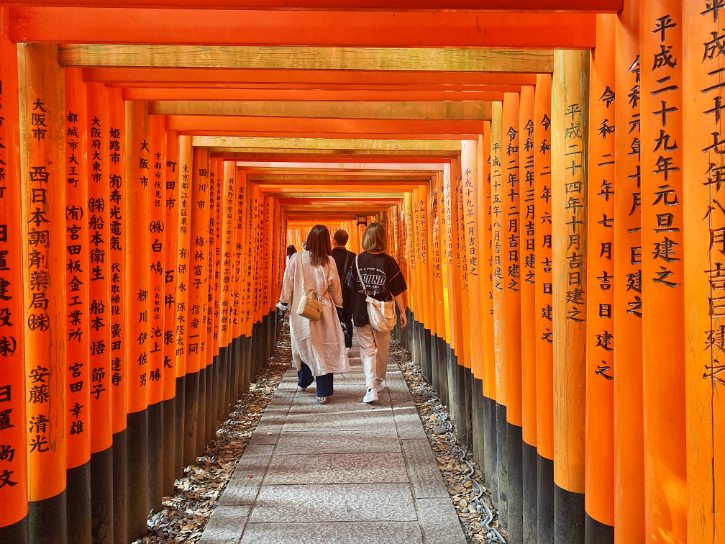
a. Key Highlights
- This is Japan’s most important Inari shrine, loved by people for over 1,300 years
- The shrine honors Inari, who brings good fortune and abundant harvests
- You’ll be amazed by the countless bright orange gates lining the paths
- These gates create magical tunnels that wind up Mount Inari
b. What to See at the Main Shrine
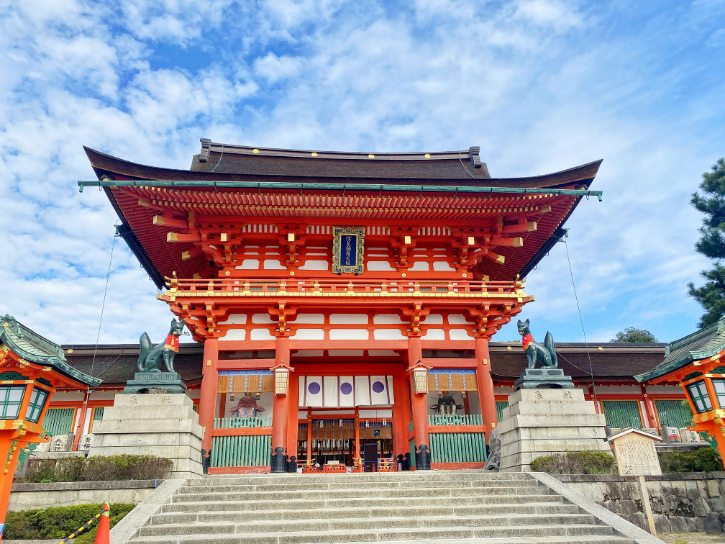
- Your journey begins at the Romon Gate, a special gift from the famous leader Toyotomi Hideyoshi in 1589
- Stop by the main hall to offer your prayers and respects
- Keep an eye out for fox statues everywhere – these friendly creatures carry messages to Inari
- Take time to read the “ema” (wooden prayer boards) where visitors write their hopes and wishes
- Look for the special fox-shaped prayer boards – you won’t find these at other shrines!
c. How to Get There
From Hotel Forza Kyoto Shijo Kawaramachi: Take the Karasuma Subway Line from Shijo Station to Kyoto Station. Transfer to the JR Nara Line and ride to Inari Station. The trip takes about 15 minutes and costs 370 yen. From Inari Station, it’s a 1-minute walk to Fushimi Inari Taisha.
Read More: Visiting Fushimi Inari Shrine in Kyoto: Your Complete Guide
11:30 AM: Fushimi Inari Sando Shopping Street + Lunch
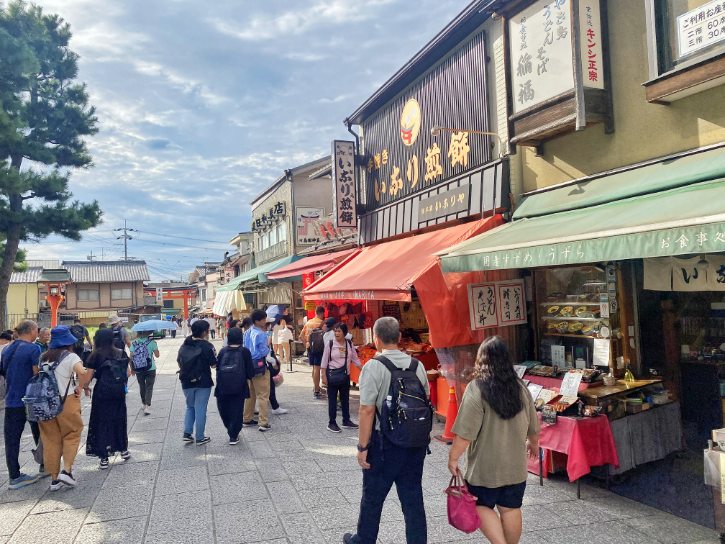
a. Key Highlights
- A vibrant street full of life and activity
- More than 20 shops and food spots to explore
- Great mix of old and new shopping options
b. Shopping Highlights
- Fox Items: Cute keychains and statues with fox designs
- Special Fox Crackers: Tasty rice crackers shaped like foxes
- Local Art: Beautiful Fushimi dolls and handmade crafts
- Good Luck Charms: Special amulets from the shrine
- Sake Cups: Pretty drinking cups, celebrating the area’s famous sake
c. Where to Eat (Lunch)
i. Fushimi Inari Sando Chaya
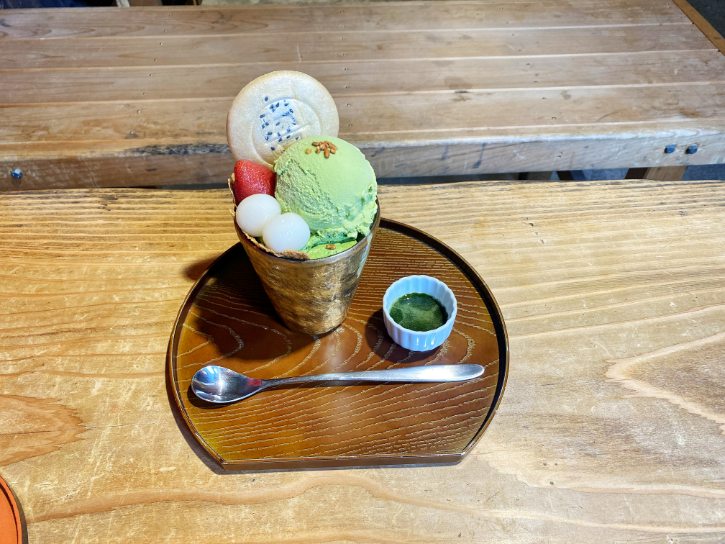
- Specialties: Traditional Japanese sweets and beverages
- Must-Try: Inari Amazake – a sweet, non-alcoholic fermented rice drink served with mochi
- Popular Desserts: Green tea parfait, shaved ice, and Inaka Mochi
- Feel: A warm, welcoming teahouse loved by everyone
- Budget: 450–1,600 yen per person
ii. Nezameya
- Specialty: Unagi (freshwater eel) dishes
- Must-Try: Unagi donburi – grilled eel over rice
- Also Popular: Unagi kaiseki – multi-course eel meal
- Other Options: Inari sushi and udon noodles
- Budget: 2,000-4,000 yen per person
iii. Teuchi-udon Kendonya
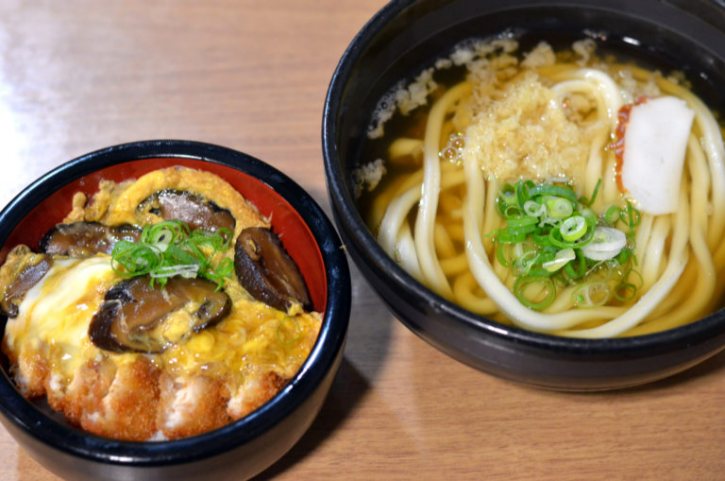
- Specialties: Handmade udon noodles crafted in-house
- Must-try: Kitsune Udon – udon with deep-fried tofu pouch
- Other favorites: Curry Udon – a fusion of Japanese curry and udon noodles
- Budget: 1,000-1,200 yen per person
iv. Oshokujidokoro Inafuku
- Specialty: Traditional Kyoto cuisine with a focus on unique local delicacies
- Must-try: Grilled sparrow on sticks – a local specialty
- Popular dishes: Inari udon, tempura udon, and Inari sushi
- Unique offering: Grilled quail
- Budget: 700-1,500 yen per person
d. How to Get There
From the Entrance of Fushimi Inari Taisha: It’s a 1-minute walk to Fushimi Inari Sando Shopping Street.
1:30 PM: Sanjusangendo Temple
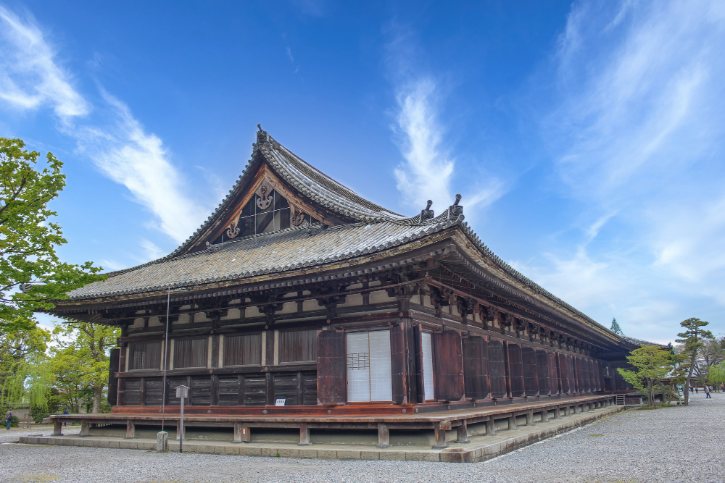
a. Key Highlights
- The name “Sanjusangendo” comes from the 33 spaces between the hall’s columns
- The temple holds 1,001 statues of the many-armed Kannon, showing Buddha’s compassion
- The building and statues are National Treasures of Japan
- This temple has been important to Kyoto for over 850 years
b. Main Attractions
- The Main Hall is Japan’s longest wooden building (120 meters)
- A large central Kannon statue (3.35 meters tall) is the temple’s treasure
- 1,000 standing Kannon statues, each with multiple arms, line up in 10 rows
- 28 guardian statues stand watch with fierce faces and detailed designs
c. How to Get There
From Fushimi Inari Sando Shopping Street: Take the Keihan Main Line from Fushimi-Inari Station to Shichijo Station. The journey takes about 10 minutes and costs 170 yen. From Shichijo Station, use Exit 2 and walk for 8 minutes to reach Sanjusangendo Temple.
2:50 PM: Nishiki-Tenmangu Shrine

a. Key Highlights
- Nishiki-Tenmangu is dedicated to Tenjin, who watches over students and learning
- Many students visit to pray for good grades, especially during exam seasons
- You can write your study wishes on special wooden boards called “ema”
b. Try the Karakuri Omikuji
- Watch mechanical lions bring you your fortune through this special machine
- Put in a 200-yen coin to see the lion move and get your fortune
- The lions perform a dance while traditional court music plays
- English fortunes are available
c. Make a Wish with Daigan Ume
- Get a “Plum of Great Wishes” (Daigan Ume) for 500 yen
- Write your wish on special paper and put it in the plum-shaped wooden box
- You can carry it with you or hang it on a tree at the shrine
- People believe your wish will slowly come true, just like a ripening plum
d. How to Get There
From Sanjusangendo Temple: Take bus #207 from the Higashiyama Nanajo bus stop to the Shijo Kawaramachi bus stop. The journey takes about 22 minutes and costs 230 yen. From Shijo Kawaramachi, walk for 4 minutes to reach Nishiki Tenmangu Shrine.
3:00 PM: Nishiki Market
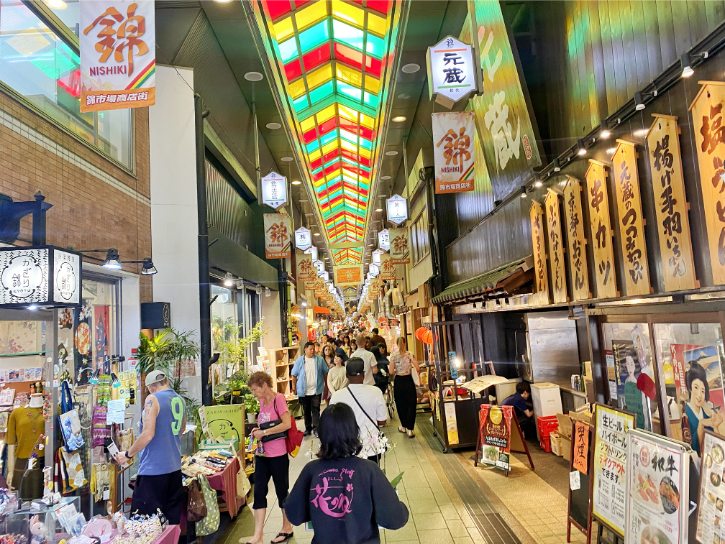
a. Key Highlights
- A narrow, covered shopping street about 400 meters long
- Over 100 shops and stalls selling food, cookware, and local specialties
- Known as “Kyoto’s Kitchen”
b. Must-Try Foods
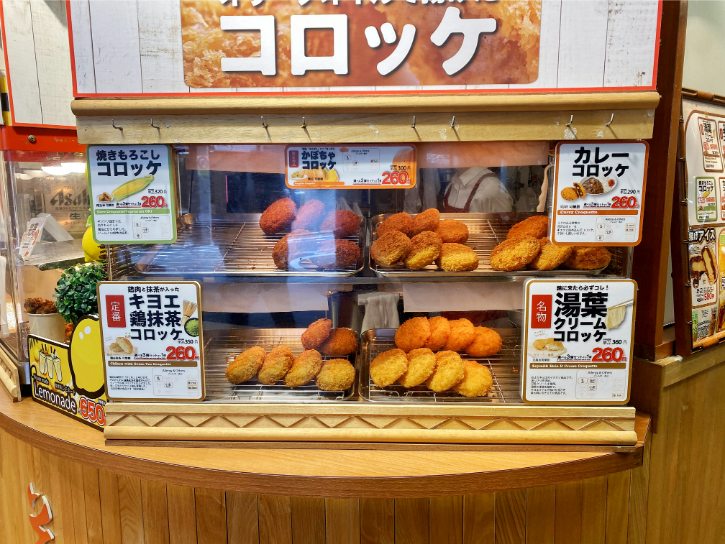
- Hanayori Kiyoe: Yuba cream croquette with crispy exterior and creamy tofu skin filling
- KAI: Tako tamago – skewered baby octopus with a quail egg in its head
- Miki Keiran: Dashimaki tamago – rolled omelet cooked in dashi broth
- Uoriki: Hamo kushi – pike conger (eel) on a skewer, available in teriyaki, tempura, or katsu style
- Marutsune Kamaboko store: Deep-fried fish cakes in various flavors
- Snoopy Cha-Ya: Snoopy-shaped soft serve ice cream
- Konna Monja: Soy milk doughnuts in various flavors
- Daiyasu: Fresh oysters – raw, steamed, or grilled
c. How to Get There
Nishiki Market is just in front of Nishiki Tenmangu Shrine.
4:30 PM: Heian Shrine
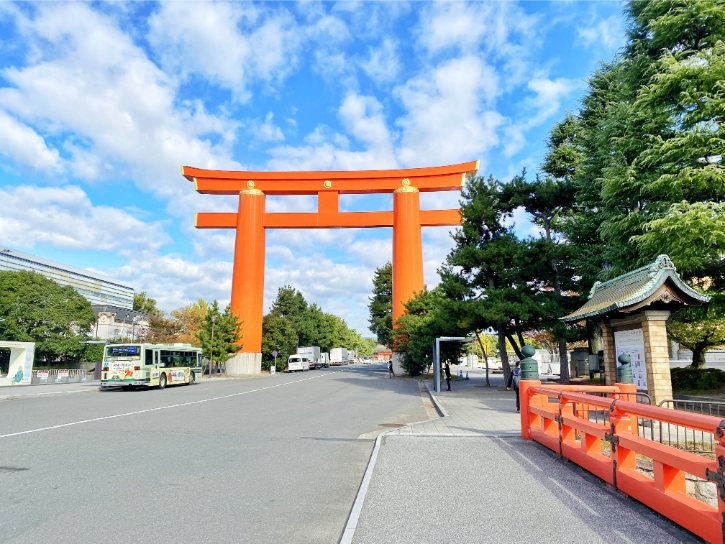
a. Key Features
- Built in 1895, making it one of Kyoto’s newer shrines
- Honors two important emperors – the first and last to rule from Kyoto
- Known for its giant entrance gate and wide open spaces
- Features stunning gardens that bloom beautifully in spring
b. Main Attractions
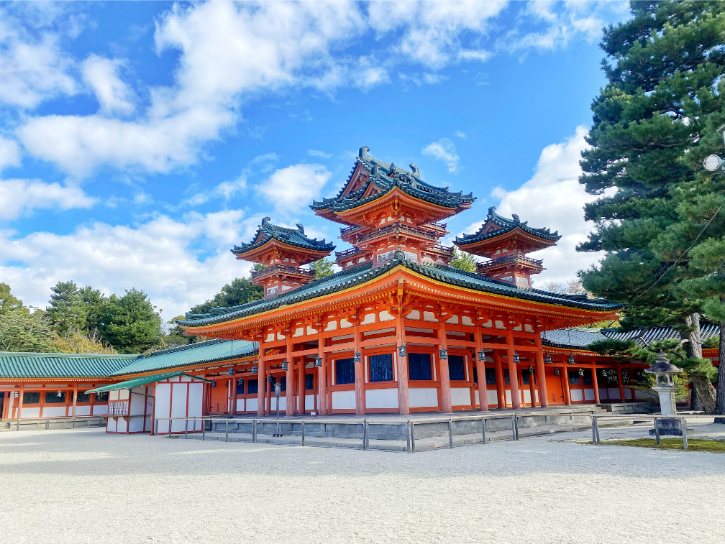
- Giant Entrance Gate: At 24.4 meters high, this massive red gate is perfect for photos and amazes visitors with its size.
- Main Gate (Otenmon): A beautiful bright red gate that’s so special it’s listed as an Important Cultural Property.
- Main Hall (Daigokuden): Built to look like part of the original Imperial Palace, this is where visitors come to pray.
- Garden (Shin-en): A huge garden covering 33,000 square meters, split into four different areas. Visitors love its cherry blossoms, purple irises, and red autumn leaves.
- Twin Towers: The Blue Dragon and White Tiger towers stand guard on each side of the main hall.
- Red Bridge (Taihei-kaku): A lovely bright red bridge that looks especially pretty when surrounded by purple irises in June.
c. How to Get There
From Nishiki Market: Take bus #46 from the Shijo Kawaramachi bus stop to the Okazaki Koen Bijutsukan / Heian Jingu-mae bus stop. The journey takes about 20 minutes and costs 230 yen. From Okazaki Koen Bijutsukan / Heian Jingu-mae, walk for 2 minutes to reach Heian Shrine.
6:00 PM: Musashi Sushi or Matsuya (Dinner)
a. Musashi Sushi
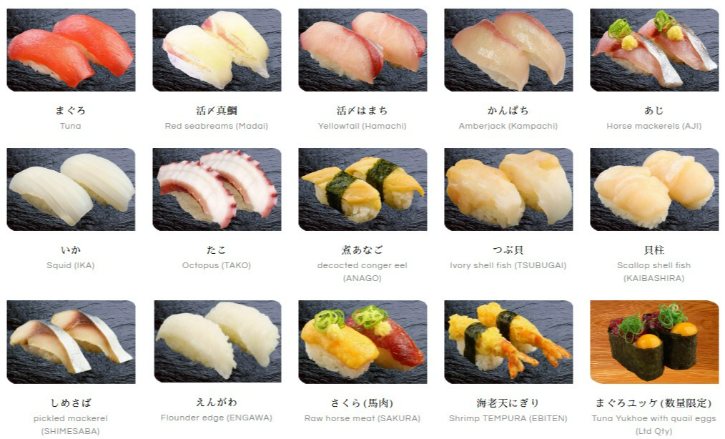
- Specialty: Fresh sushi made by authentic sushi chefs
- Must-Try: Kitayama set (35 pieces, serves 3) for 3,078 yen
- Popular Choice: Yasaka set (11 pieces, serves 1.5) for 918 yen
- Tuna Lovers: “Maguro-zukushi” (full plate of tuna) for 738 yen
- Unique Item: Saba no Isomaki (mackerel sushi rolled in kelp, 4 pieces) for 370 yen
- Budget: 700-3,100 yen per person
How to Get There
From Heian Shrine: Take bus #5 from the Okazaki Koen Bijutsukan / Heian Jingu-mae bus stop to the Kawaramachi Sanjo bus stop. The journey takes about 14 minutes and costs 230 yen. From Kawaramachi Sanjo, walk for 1 minute to reach Musashi Sushi.
b. Matsuya – Kyoto Sanjo
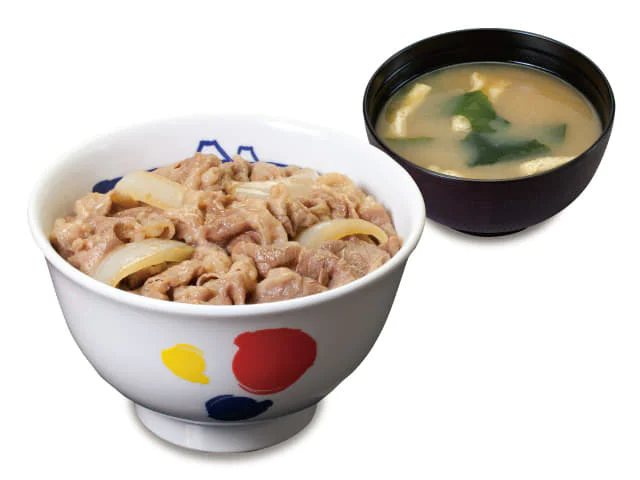
- Specialty: Budget-friendly Japanese fast food
- Signature Dishes:
- Beef Bowl (Gyudon): Thinly sliced beef over rice.
- Grilled Thick Kalbi Pork Meal: Flavorful pork with sides.
- Hamburg Steak in Brown Sauce: Juicy patty with rich sauce.
- Budget: 430-1,000 yen per person
How to Get There
From Heian Shrine: Take bus #5 from the Okazaki Koen Bijutsukan / Heian Jingu-mae bus stop to the Sanjo Keihan-mae bus stop. The journey takes about 8 minutes and costs 230 yen. From Sanjo Keihan-mae, walk for 3 minutes to reach Matsuya – Kyoto Sanjo.
7:00 PM: Kawaramachi Shopping Street and Shijo Street
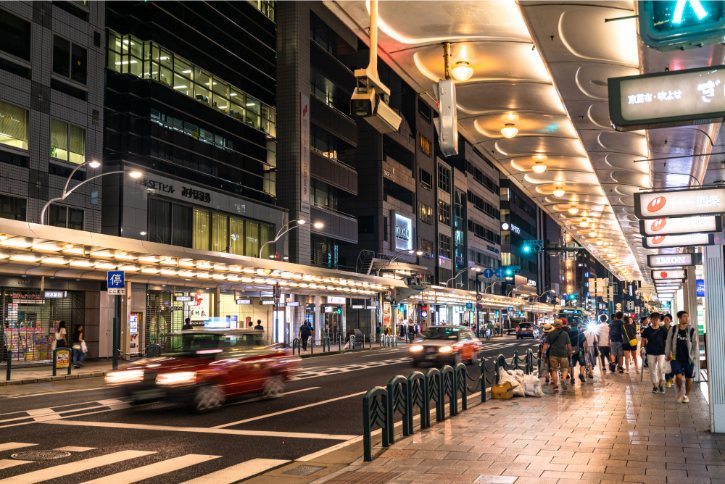
a. Shopping Highlights
- Department Stores: Find Kyoto Takashimaya S.C. at the Kawaramachi Station intersection. A highlight is Kyoto’s first Nintendo flagship store, added after October 2023 renovations.
- Boutique Shops: Discover Shinkyogoku Shopping Street near Kyoto-Kawaramachi Station. This 800-meter street has about 180 shops selling general items and gifts.
- Traditional Crafts: Browse Shijo Street for Kyoto’s traditional crafts and local foods. The street mixes modern fashion stores with historic shops.
- Fashion: Check out Fujii Daimaru on Shijo Street, popular with young shoppers for its fashion brands and HARBS cake shop.
b. Major Fashion Retailers
- Disney Store: Get Disney items at the Kyoto Shijo-Kawaramachi location.
- Uniqlo: Find a large store in Mina Kyoto complex with clothes for men, women, and children.
- H&M: Shop for trendy, affordable fashion on Kawaramachi Dori.
- ZARA: Find latest fashion at the Kawaramachi store.
c. Discount Shopping
- Don Quijote Shijo Kawaramachi: Browse this fun discount store for everything from food to electronics and souvenirs.
d. How to Get There
From the Restaurants Mentioned Above: It’s about a 1-minute walk to Kawaramachi Shopping Street and Shijo Street.
Day 3: Arashiyama Bamboo Forest, Tenryuji Temple, Kinkakuji and Nijo Castle
9:30 AM: Take the Sagano Romantic Train for a Scenic Journey
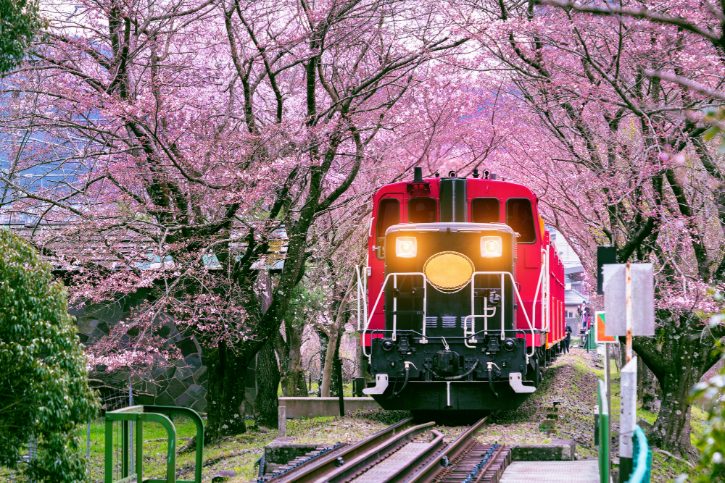
a. Key Highlights
- The Sagano Romantic Train is a beautiful sightseeing train that takes you through the scenic areas of Kyoto
- The train travels 7.3 kilometers between Saga-Arashiyama Station and Kameoka Station
- Your journey lasts about 25 minutes, giving you amazing views of the Hozugawa River and mountains along the way
- The train runs most of the year (March 1st to December 29th) but takes a break in January and February
- You can ride any day except Wednesdays (if Wednesday is a holiday, it closes on Thursday instead)
b. What You’ll See
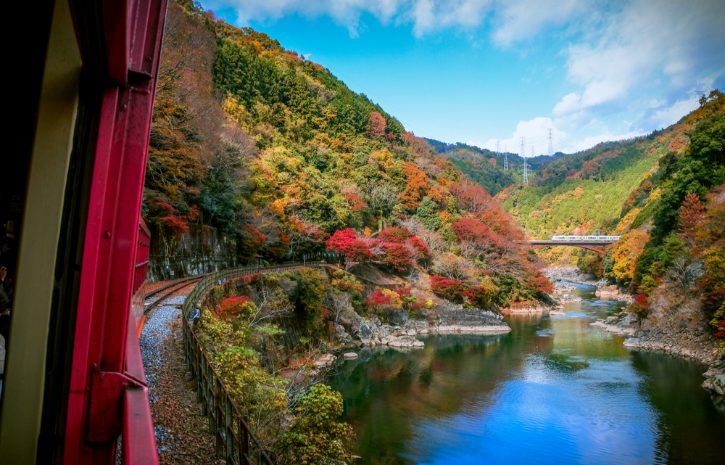
- Beautiful views of the Hozugawa River valley as you travel
- Local birds and other wildlife, especially near the water
- Eight different tunnels along your journey
- Exciting moments when the train enters and exits through mountain tunnels
c. How to Make the Most of Your Ride

- For the best views, try to get a seat in Car No. 5 – it’s open-air!
- Pack a light jacket because it can get cool, especially in the open car
- Show up 30 minutes before departure to get your preferred seats
- You might want to visit the famous Arashiyama Bamboo Grove while you’re in the area
d. Tickets and Prices
- Adults (12 years and older): 880 yen for one way
- Children (6-11 years): 440 yen for one way
- All seats must be reserved, and booking ahead is really important during busy seasons
e. How to Get There
From Hotel Forza Kyoto Shijo Kawaramachi: Take the Karasuma Subway Line from Shijo Station to Kyoto Station. Transfer to the JR San-In Line and ride to Umahori Station. The trip takes about 40 minutes and costs 550 yen. From Umahori Station, walk to Torokko Kameoka Station and board the Sagano Romantic Train to Torokko Arashiyama Station.
Why start from Torokko Kameoka Station instead of Torokko Arashiyama Station? It’s less crowded, and you can avoid a return trip, making it easier to visit nearby attractions like the Arashiyama Bamboo Forest and Tenryuji Temple.
10:00 AM: Arashiyama Bamboo Forest
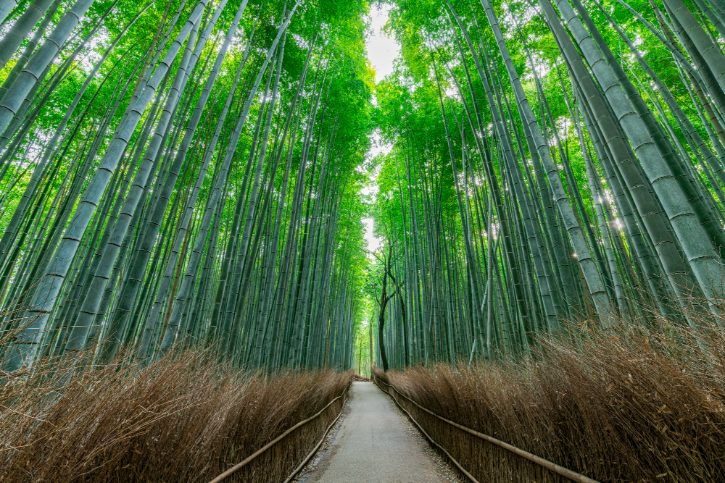
a. Key Highlights
- Majestic green bamboo trees that stretch high into the sky
- A lovely path that takes you through the heart of the forest
- One of Kyoto’s most photographed spots, seen on postcards everywhere
- Beautiful natural music created by bamboo swaying in the wind
b. Walking Through the Grove
- The main bamboo path is quite short – just a 5-minute walk (about 300 meters)
- Make sure to look up – the bamboo reaches amazingly high above you
- Stop and listen to the gentle sounds of bamboo leaves dancing in the wind
- Take it slow and enjoy the calm setting, even if there are other visitors around
c. Photography Tips
- Bring a wide-angle camera lens to capture how tall the bamboo grows
- Point your camera up for some stunning shots of the bamboo canopy
- Visit in the morning for beautiful sunlight filtering through the trees
d. How to Get There
From Torokko Arashiyama Station: It’s a 3-minute walk to Arashiyama Bamboo Forest.
10:30 AM: Tenryuji Temple
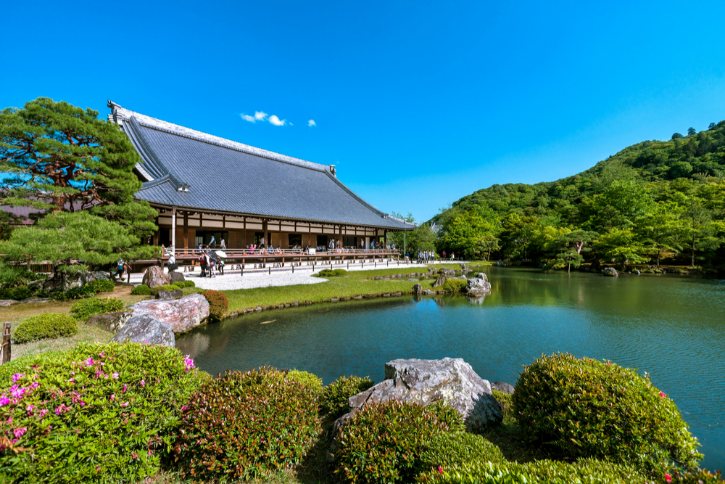
a. Key Highlights
- A treasured UNESCO World Heritage Site and one of Kyoto’s top 5 Zen temples
- Home to the beautiful Sogenchi Garden, a national historic treasure
- Features the Hojo (head priest’s home) with classic Japanese design
- Houses the Hatto (main hall) with its famous dragon painting on the ceiling
- Includes the Kuri (where monks live) with its charming tower and special Daruma painting
b. What to See
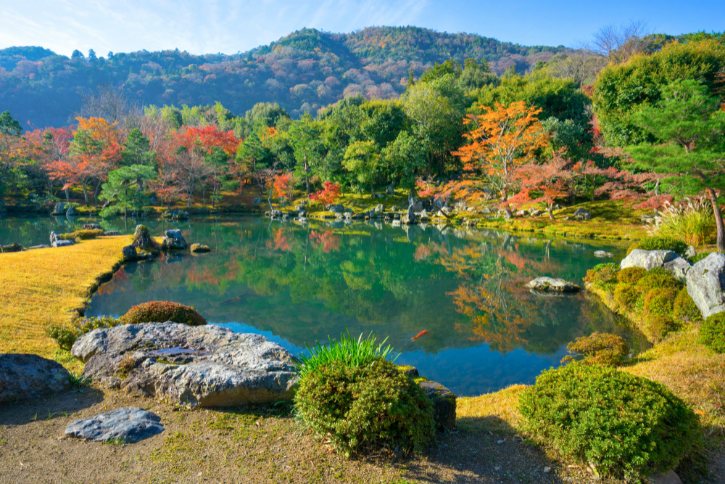
- Walk through Sogenchi Garden – a masterpiece created by Muso Soseki, with a peaceful pond at its heart
- Begin your visit at the Kuri, where you can get your ticket and see the special Daruma painting
- Stop by the Hojo to enjoy its beautiful Japanese architecture and garden views
- Don’t miss the Hatto to look up at the amazing dragon painted on the ceiling
c. How to Get There
From Arashiyama Bamboo Forest: It’s a 2-minute walk to Tenryuji Temple.
12:00 PM: Arashiyama Yoshimura (Lunch)
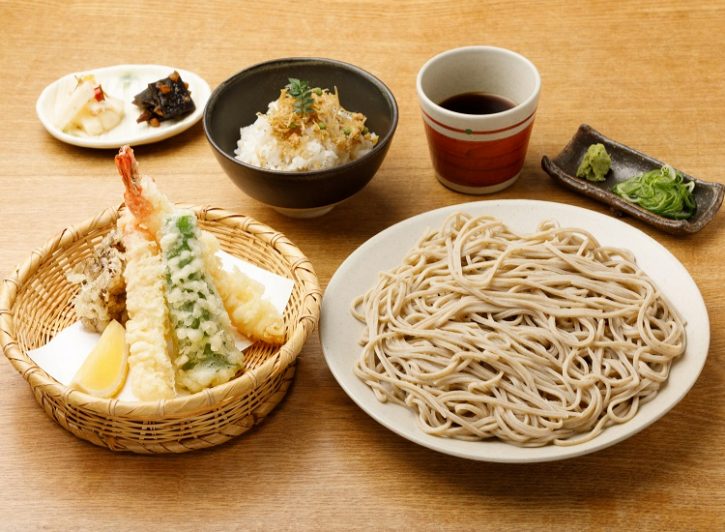
Arashiyama Yoshimura in Kyoto serves delicious soba noodles in a beautiful location overlooking the famous Togetsukyo Bridge and surrounding mountains.
a. Signature Soba Dishes
- Fresh soba noodles made daily using high-quality Japanese buckwheat flour
- Best seller: Tenzaru Zen set – comes with soba, assorted tempura, special herring rice, and traditional pickles
- Chilled soba with dipping sauce – perfect for hot days
- Warming hot soba in soup – ideal for winter visits
- Special soba dishes that follow the changing seasons
b. Tempura Selections
- Light and crispy tempura using the day’s fresh ingredients
- Fan favorite: Mixed tempura plate featuring seasonal vegetables and seafood
- Special kakiage – a delicious crispy patty of mixed vegetables and seafood
- Add tempura to your meal or enjoy it as a side dish
- Vegetable tempura available for vegetarian guests
c. Budget and Pricing
- Expect to spend 1,800-3,000 yen per person
- Set meals give you the best value, including noodles, tempura, and side dishes
d. How to Get There
From Tenryuji Temple: It’s a 5-minute walk to Arashiyama Yoshimura.
1:00 PM: Togetsukyo Bridge
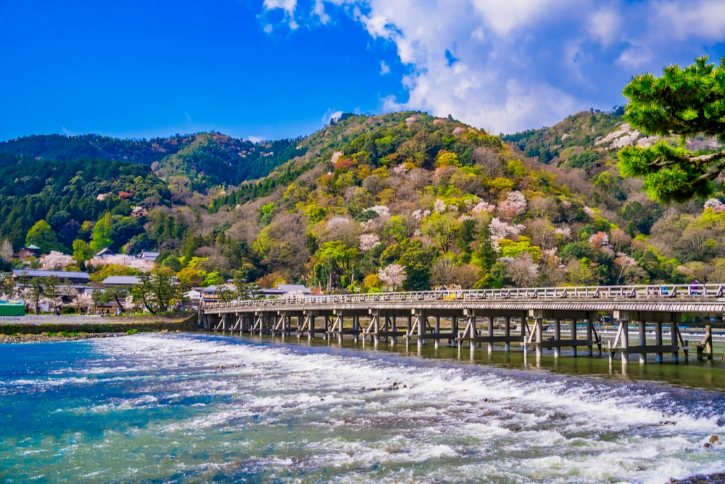
a. Key Highlights
- Iconic bridge spanning the Katsura River in Arashiyama
- Gets its lovely name “Moon Crossing Bridge” from an ancient emperor who saw the moon appearing to cross the bridge
- From the bridge, you can see the Katsura River below and mountains all around
- Best times to visit: spring for cherry blossoms and fall for colorful leaves
b. What You Can Do
- Take photos – the bridge and scenery are perfect for pictures
- Walk across to enjoy the mountain views
- Try something special – ride in a traditional rickshaw pulled by a friendly guide across the bridge
c. How to Get There
From Arashiyama Yoshimura: It’s a 1-minute walk to Togetsukyo Bridge.
2:00 PM: Kinkakuji
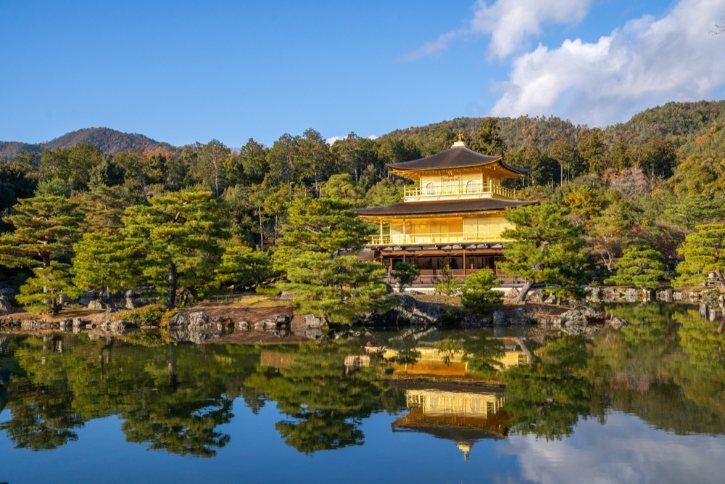
a. Key Highlights
- A stunning temple covered in real gold leaf that glitters beautifully in the sun
- The temple creates a perfect mirror image in the pond – it’s a photographer’s dream!
- Surrounded by a serene traditional Japanese garden
- One of the most popular and recognizable sights in Kyoto
b. What to See and Do
- Capture amazing photos of the golden temple reflecting in the still water
- Look up to find the golden phoenix perched on top of the roof
- View the temple from outside (the inside is closed to visitors)
- Take a stroll around the pond to discover new angles of the temple
c. Exploring the Gardens

- Make a wish and throw a coin at the good-luck statues
- Take the visitor path – it guides you to all the best viewpoints
- Stop by the special Anmintaku Pond, famous for its water that never dries up
- Take your time to soak in the calm and beauty of the garden
d. How to Get There
- From Togetsukyo Bridge: Take the Randen Tram (Arashiyama Line) from Arashiyama Station to Katabiranotsuji Station. Transfer to the Randen Tram (Kitano Line) and ride to Kitanohakubaicho Station. From there, take bus #204 from the Kitano Hakubaicho bus stop to the Kinkakuji-michi bus stop. The entire trip takes about 40 minutes and costs 480 yen. From Kinkakuji-michi, it’s a 1-minute walk to Kinkakuji Temple.
- Alternative Option: Take a taxi from Togetsukyo Bridge to Kinkakuji Temple for about 2,600 yen.
3:30 PM: Nijo Castle
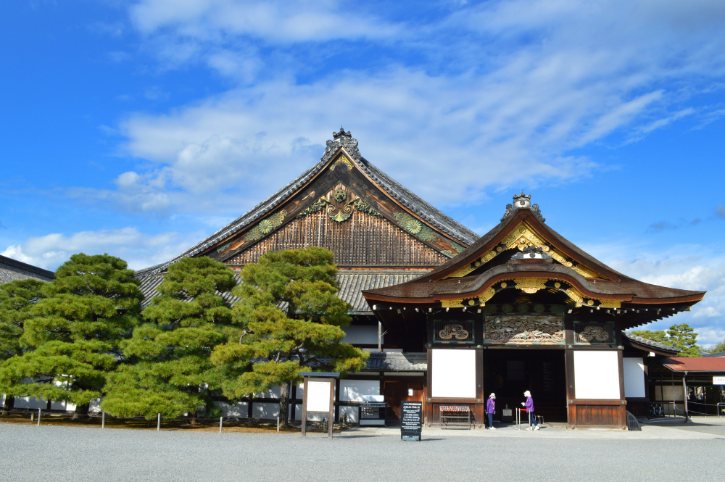
a. Key Highlights
- Built in 1603 as the Kyoto residence of Japan’s most powerful ruler, Tokugawa Ieyasu
- A UNESCO World Heritage site that shows how Japan’s military rulers lived
- Has special floors that make squeaking sounds when you walk on them – they were used to warn against intruders
- The best example of a real Japanese castle palace that you can visit today
b. What to See
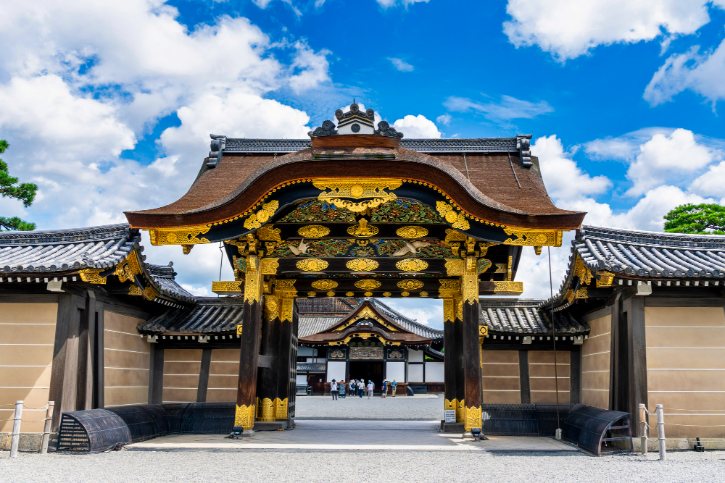
- Karamon Gate: A stunning entrance decorated with gold and intricate designs.
- Ninomaru Palace: Known for its beautiful room decorations and painted sliding doors.
- The “nightingale floors”: Walk on them to hear their unique squeaking sound.
- Castle defenses: See the high stone walls, wide moats, and guard towers.
- Ninomaru Garden: A lovely traditional garden right next to the palace.
c. How to Get There
From Kinkakuji Temple: Take bus #12 from the Kinkakuji-michi (Kinkakuji Temple) bus stop to the Nijojo-mae (Nijo-jo Castle) bus stop. The journey takes about 25 minutes and costs 230 yen. From Nijojo-mae (Nijo-jo Castle), walk for 2 minutes to reach Nijo Castle.
5:30 PM: Tendon Makino Kyoto Teramachi or Gyukatsu Kyoto Katsugyu (Dinner)
a. Tendon Makino Kyoto Teramachi
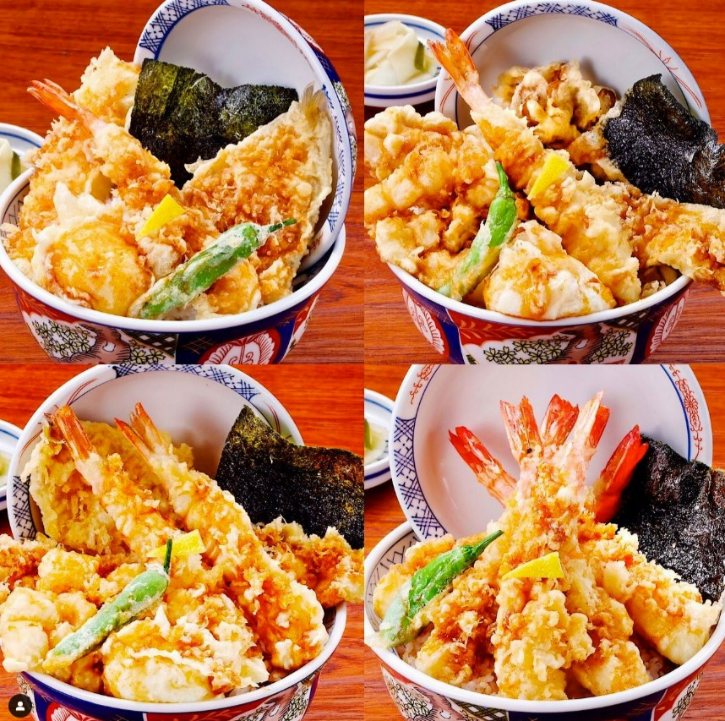
- Specialty: Tempura rice bowls (tendon)
- Must-Try: Regular Tendon Set A for about 1,650 yen
- Includes a variety of tempura items such as shrimp, fish, squid, vegetables, and sweet potato
- Served with rice, miso soup, and pickles
- Popular Choice: Ebidukushi-Tendon Set, featuring a tempura rice bowl loaded with shrimp, priced at 2,500 yen
- Unique Features: An open kitchen where you can watch skilled chefs expertly prepare tempura right in front of you
- Budget: 1,500–2,500 yen per person
How to Get There
From Nijo Castle: Take bus #12 from the Nijojo-mae (Nijo-jo Castle) bus stop to the Shijo Kawaramachi bus stop. The journey takes about 20 minutes and costs 230 yen. From Shijo Kawaramachi, walk for 6 minutes to reach Tendon Makino Kyoto Teramachi.
b. GYUKATSU Kyoto Katsugyu Shijo Kawaramachi

- Specialty: Deep-fried wagyu beef cutlets (gyukatsu)
- Must-Try: Sirloin Gyukatsu Set for about 2,300 yen
- Popular Choice: Tenderloin Gyukatsu Set
- Premium Option: Wagyu Gyukatsu Set
- Each Set Includes: Rice, miso soup, shredded cabbage, and various dipping sauces
- Budget: 2,000-3,300 yen per person
How to Get There
From Nijo Castle: Take bus #12 from the Nijojo-mae (Nijo-jo Castle) bus stop to the Shijo Kawaramachi bus stop. The journey takes about 20 minutes and costs 230 yen. From Shijo Kawaramachi, walk for 1 minute to reach GYUKATSU Kyoto Katsugyu Shijo Kawaramachi.
6:20 PM: Shinkyogoku Shopping Street
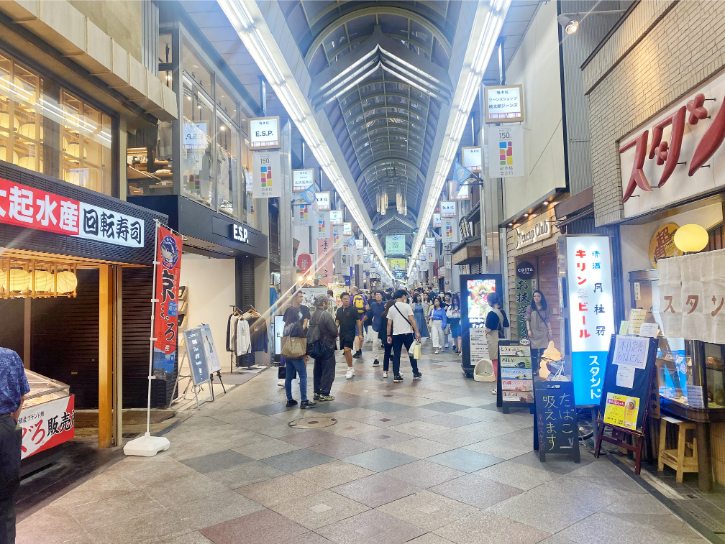
a. Shopping Experience
- One of Kyoto’s most beloved shopping streets, featuring a covered walkway to protect you from rain or sun
- You’ll find both old-style Japanese shops and modern retail stores side by side
- Perfect spot to pick up gifts, try local snacks, and find unique Japanese items
- Always bustling with energy – grab some street food or try the fun arcade games
b. Shopping Highlights
- Kyoto Crafts: Find beautiful handmade items like pottery, fans, and kimono fabrics.
- Fashion: Shop for trendy clothes, accessories, and shoes loved by locals.
- Anime & Manga: Get fun character goods and collectibles from popular series.
- Beauty Items: Discover Japanese makeup, skincare, and face masks.
- Japanese Sandals: Try on traditional geta (wooden) or zori (flat) sandals.
- Local Souvenirs: Pick up Kyoto treats like sweet cookies, local tea, and mini shrine gates.
c. How to Get There
From the Restaurants Mentioned Above: It’s about a 2-minute walk to Shinkyogoku Shopping Street.
Related Posts
Photo Credit:
Photos by PIXTA

